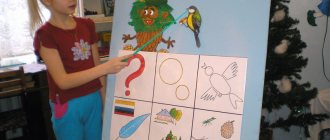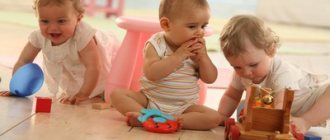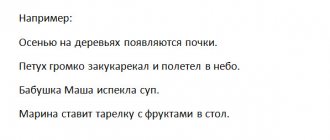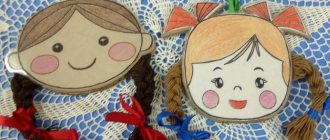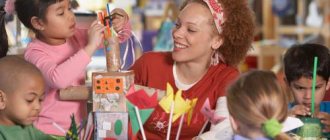Speech development in the middle group of preschool educational institutions
The development of communication and speech skills, which includes enriching vocabulary and developing clear pronunciation, is considered one of the main tasks for preschoolers.
Speech development lesson
Note! For the correct speech development of children in the middle group, educators do a tremendous amount of work. It is based on a set of special exercises and methodological techniques aimed at improving speech skills and developing a high culture and politeness of speech.
To develop speech in the middle group of preschool educational institutions, various directions are used:
- children’s knowledge and ideas about surrounding objects deepen;
- children become familiar with the details and names of parts of things;
- words denoting the properties of objects and phenomena are studied;
- vocabulary in the field of professions is replenished;
- words that denote relationships between people are studied;
- children learn to express their own thoughts in complex sentences that are grammatically correct.
To solve the assigned tasks in the middle group, the teacher must take a responsible approach to the process and purposefully conduct classes.
Federal State Educational Standards requirements for speech development
All educational institutions, regardless of whether they are public or private, must focus on certain program requirements that are specified in the Federal State Educational Standard.
As for the speech development of preschoolers, the requirements are as follows:
- Vocabulary must be constantly enriched;
- the child must have speech skills in accordance with age;
- the sound and intonation range of speech expressiveness should expand;
- develop the ability to perceive sounds by ear and at the same time hear, identify and, if there are errors, correct them;
- develop the ability to listen and remember the storyline;
- develop logically consistent and meaningful speech;
- skills of retelling and acting out dialogues;
- the child must learn to convey the meaning emotionally and read a poem by heart with expressiveness;
- work should be carried out to expand the horizons of preschoolers about objects, properties, phenomena and the concept of a coordinate system;
- generalizing concepts are introduced into the lexicon;
- training is provided to improve the grammatical construction of sentences.
Note! All training sessions should be conducted by the teacher so that they simultaneously include solving assigned problems and game moments. Only in this case will it be possible to interest children and achieve the desired results.
Directions of speech development (FSES DO)
Age-related psychological characteristics of children in the middle group of preschool educational institutions
In terms of development, middle preschool age is a continuation of early childhood. During this period, children master the world of permanent things, master the culture of speech, and the formation and development of psychological perception also occurs.
In middle age, children continue to actively develop speech, substitution ability, thinking and imagination. With the help of speech, middle group students express their emotions and share their impressions.
Note! There is a rapid development of memorizing information and retaining it in memory, and the ability to concentrate is also enhanced.
As a rule, at this age, kindergarten teachers conduct special planned classes on speech development. They are provided for by special educational standards. But, despite this, pedagogical work in this direction is not limited to a certain framework. The most important thing is that when selecting tools, the teacher must take into account all the age characteristics of his students.
Articulation gymnastics for the sounds Ш and Ж
Methodological tools
Within the framework of the requirements of speech development, the teacher faces serious tasks that force him to approach the process thoughtfully, responsibly and in accordance with certain standards.
Basic pedagogical techniques
Each lesson on speech development in the middle group should be based on a specific pedagogical technique. Currently, three main groups of speech development techniques in preschool institutions have been identified. These are verbal, visual and playful techniques.
Their essence is as follows:
- Teaching stories using story pictures.
- Daily reading of fiction, which is provided for in the educational program.
- Carrying out work with children in a conversation format.
- Application of gaming technologies.
- Systematic and unobtrusive repetition of a new word.
- Motivation to complete the curriculum.
Note! In addition to implementing the pedagogical techniques listed above, the teacher must organize physical education sessions for students. They are also part of the curriculum and help to develop a serious attitude towards physical education in children.
Games for speech development
By the age of five, children should learn to pronounce all sounds correctly. You can achieve your goal through daily breathing exercises.
Didactic games on “Speech Development”
You can form grammatically correct speech thanks to games and exercises:
- "More less".
- “Call me kindly.”
- “Whose toy?”
- “Continue the sentence.”
- "Which".
Speech corner equipment
In order to stimulate independence and informal playful communication with children, in accordance with the requirements of the Federal State Educational Standard, an aesthetically attractive, comfortable and special subject-development environment must be created in which children will not be afraid, but rather feel at ease and at ease.
Important! It is best to place the speech corner away from the playing area in a well-lit place. It must be equipped with didactic and visual aids, as well as the necessary materials that are used by the teacher during classes.
Speech corner
Table: filling out the speech corner by section
| Chapter | Content |
| Certificate | Schemes of words, sentences and corresponding games (“Add a word”, “Choose a word”), puzzles and crosswords. |
| Connected speech | Subject pictures, “Playing in the profession”, “Guess by the description”. |
| Grammar | Games “Name it affectionately”, “One-many”. |
| Vocabulary | Pictures, lotto, puzzles. |
| Sound pronunciation | Game exercises, games to automate sounds. |
| Breath | Pipes, bubbles, balloons for inflation. |
| Fine motor skills | Pencils, puzzles, mosaics, tops. |
| Phonetic hearing | Sound differentiation games. |
| Articulation gymnastics | Pictures, sets of exercises, methodological literature. |
| Higher mental functions | Dominoes, cut pictures. |
Note! Among other things, experts recommend having Ushakova’s book “Speech Development” in the speech corner. It examines in detail all the problems of speech development for children in the middle group, selects methodological recommendations and compiles lesson notes.
Summary of a lesson on speech development in the middle group “Visiting the forester”
Author: teacher,
MADO CRR d/s No. 8, Ishim
Usoltseva Svetlana Yakovlevna
Tasks:
1. Learn to distinguish words with a certain sound by ear. Practice changing words using suffixes.
2.Develop phonemic awareness and children’s vocabulary.
3. Foster a love of nature.
Progress of the lesson:
“All the children gathered in a circle, I am your friend and you are my friend. Let's hold hands tightly. And let's smile at each other"
Educator: Guys, look, a balloon has arrived! - Children, look, there is a letter here. Let's read it! Hello girls and boys!
I invite you to visit. I will be very glad to meet you!
Forester.
- It turns out that the forester invites you to visit him. - Do you know who the forester is? Where does he live? What is the name of his house? (guardhouse) (A forester is a person who watches over the forest so that no one offends animals in the forest, throws garbage, breaks trees, or picks flowers) - Do you agree to go for a visit? - Who will show us the way there? Look, bee. Let's ask her
“Bee, bee - show me, Bee, bee - tell me. How to find the path to the forester’s lodge?” I'll show you of course. But, I wanted to ask you, do you know the song of the mosquito (z-z-z-z), the song of the beetle (z-z-z-z) , the wind (sh-sh-sh-sh) , the water (s-s -s-s) . Let's play. I will name the words, and you should clap your hands if you hear the mosquito’s song (Z) - zebra, car, umbrella, winter, snow; fence. song of a beetle (F) - belly, giraffe, house, apple, beetle, hedgehog, knife; wind song (Ш) - hat, fur coat, candy, cone, car; water song (C) - table, chair, hand, elephant, plane, tree. - What great fellows you are! Further on your way you will meet a squirrel, she will show you the way. Look, here comes the squirrel. Let's ask her. “Squirrel, squirrel - tell me, Squirrel, squirrel - show me, How to find the path to the forester’s lodge?” I'll show you. Just play with me. D/i “Name it in one word”
butterfly, beetle, mosquito, fly, bee, dragonfly - insects;
birch, oak, spruce, maple, pine, cedar - trees;
starling, bullfinch, owl, magpie, cuckoo, swallow - birds;
lingonberries, strawberries, raspberries, currants - berries; chamomile, bell, rose, lily of the valley, cornflower - flowers;
fox, wolf, bear, hare, squirrel, hedgehog - animals
- Well done! Now play the game “Small - Big” . “A hedgehog has small paws, and a bear has big paws. A hedgehog has a small nose, and a bear has a large nose. A hedgehog has small eyes, and a bear has large eyes. A hedgehog has a small head, and a bear has a large head. "
Fizminutka
Are you probably tired? Then everyone stood up together.
One - squat, two - jump, this is a rabbit exercise...
Well done! Go further, you will meet a bunny there, he will show you the way further. “Bunny, bunny - show me, Bunny, bunny - tell me, How to find the path to the forester’s lodge?” Certainly! If you play with me.
D/i “Call it affectionately” Leaf - leaf , mushroom - mushroom , branch - twig , bush - bush , berry - berry ,
grass - grass , caterpillar - caterpillar , beetle - beetle , Christmas tree - Christmas tree, flower - flower. rain - rain .
Sl./i “Who was who?” A fox is a fox cub , a wolf is a wolf cub , a bear is a bear cub , a squirrel is a squirrel , a hedgehog is a , a tiger is a tiger cub , an elephant is a cub , a lion a lion cub , a hare is a hare , a mouse is a mouse. Well done! I really enjoyed playing with you. Go further, meet a hedgehog there, he will show you the way. Bon Voyage!
- Look, hedgehog. Let's ask him. “Hedgehog, hedgehog - tell me, Hedgehog, hedgehog - show me, How to find the path to the forester’s lodge?” I'll show you and tell you. Just answer my questions: - Who lives in the forest? — What are the names of the animals that live in the forest? - Do you know which animal changes its winter coat for a summer one? — What do birds do in the spring? — What benefits do birds bring? — How do people take care of birds? —Which trees are green in summer and winter? — What can’t you do in the forest? Well done! You know a lot. Go quickly to grandpa the forester, he’s probably already tired of waiting for us. Forester - Hello guys! What a great fellow you are for coming to visit me. And my forest dwellers have already told me by mail that you played with them and did not offend them. Please tell us who you met in the forest? What games did you enjoy playing? - Thank you for coming to visit me. I will treat you to honey that the bee collected.
We invite teachers of preschool education in the Tyumen region, Yamal-Nenets Autonomous Okrug and Khanty-Mansi Autonomous Okrug-Yugra to publish their teaching materials: - Pedagogical experience, original programs, teaching aids, presentations for classes, electronic games; — Personally developed notes and scenarios of educational activities, projects, master classes (including videos), forms of work with families and teachers.
Why is it profitable to publish with us?
1. “Kindergartens of the Tyumen Region” is an officially registered specialized media outlet at the federal level. 2. The activities of the editorial office are supported by the Department of Education and Science of the Tyumen Region 3. We issue a “Certificate of Publication” in the media. 4. The document has a unique number, is entered in the register, has the original seal of the editorial office of the online publication and signature. 5. “Certificate of publication” in the media is sent to the author in both paper and electronic versions.
Details >>>
Sample “Certificate of publication of author’s methodological material in the media.”pdf
Share
Lesson on speech development in the middle group
Planning lessons should be carried out according to methodological recommendations.
Lessons on fairy tales
Lesson structure
Each lesson should be conducted according to a specific scheme:
- The organizational introductory part is characterized by a motivating and stimulating nature. The main task of the teacher at this stage is to get the children into the mood for work and awaken their interest in the topic.
- Practical part - the teacher sets the tasks and explains the essence of the task.
- Active work - children complete tasks in conjunction with a verbal assessment of the students’ activities.
- Summing up - the teacher’s goal is to draw children’s attention to the result.
Articulation gymnastics for the sound R
